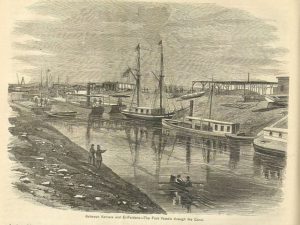
Image Source: Appleton’s Journal of Popular Literature, Science, and Art, 1869
Public Domain via Wikimedia Commons
When the Suez Canal officially opened to ships on 17 November 1869, it changed forever how important cargo and passengers would reach Asia. Up until it opened, ships went down the African coast to Cape Agulhas, the southernmost point of Africa (where the Atlantic and Indian oceans meet), to enter Asia. It was certainly a shorter trek than going overland (which used to be the case until the Ottoman Empire closed them off forcing Europeans to find alternative routes to get spices from Asia) but still took a while especially when you had to rely on wind and current to get you there. The Suez Canal cut the travel time substantially and only ships that could not fit into the canal would have to take the longer route.
The genesis of the Suez Canal began in 1854 when Ferdinand de Lesseps (former French consul to Cairo), negotiated a treaty with the Ottoman governor of Egypt to build a canal 1oo miles across the Suez isthmus. Plans were drawn up by an international team of engineers and c0nstruction began in 1859. The Suez Canal Company (formed 1856) was given the right to operate the canal for 99 years. Initial work was done by hand, making it slow until dredgers and steam shovels arrived from Europe. Both labor disputes and a cholera epidemic slowed construction causing a four-year delay in getting it completed. When it opened in 1869, it was only 25 feet deep, 75 feet wide at the bottom, and 200-300 feet wide on the surface. This resulted in less than 500 ships using it the first year. Major improvements would be made in 1876 that allowed for nearly all the ships of the day (and today as well) to pass through it. The Suez Canal became one of the most heavily trafficked shipping lanes in the world.
Aftermath
The British decided to get control of the Suez Canal. In 1875, Great Britain bought the stock of the new Ottoman governor making them the largest shareholder in the Suez Canal Company. When they invaded and took control of Egypt in 1882, they took control of the Suez Canal as well. Later under the Anglo-Egyptian Treaty of 1936, the Egyptian government (now nearly independent of England), Britain retained rights to protect the canal. In July 1956 Egyptian President Gamal Abdel Nasser nationalized the canal. This resulted in the Suez Crisis of 1956 in which Israel invaded Egypt and British and French troops arrived to occupy the Canal Zone. In 1957, both Britain and France withdrew under international pressure and in March 1957, the canal was once again open to commercial traffic. It would shut again in 1967 during the Six Day War. Tensions between Egypt and Israel would make the Suez Canal a front line between both parties. In 1975 Anwar Sadat would reopen the canal as a gesture of peace and negotiate a peace treaty with Israel. Today the canal plays a vital role in shipping cargo from Asia to Europe and North America. Its strategic importance is recognized by all powers in the region occasionally causing scuffles or even attacks by belligerents wanting to disrupt oil and cargo shipments.
Sources:
Smith, Charles Gordon, and William B. Fisher. “Suez Canal | History, Map, Importance, Length, Depth, and Facts.” Encyclopedia Britannica, 6 Nov. 2023, www.britannica.com/topic/Suez-Canal.
“Suez Canal Opens.” HISTORY, 9 Feb. 2010, www.history.com/this-day-in-history/suez-canal-opens.
